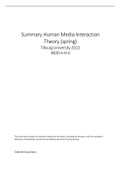Samenvatting
Summary Human Media Interaction Theory (Spring) (880014-M-6)
This summary contains all relevant material for the exam, including lectures, and the mandatory literature of the Master course Human Media Interaction Theory (Spring 2022)
[Meer zien]













